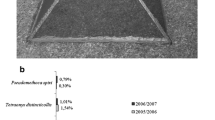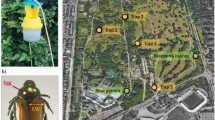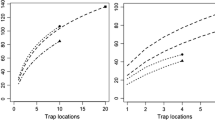Abstract
Brachymeria intermedia (Nees), a pupal parasitoid of the gypsy moth, was caught in the field using plexiglas traps coated with Tangletrap (2). Significantly greater numbers of females were collected in traps baited with gypsy moth pupae than in traps with male or femaleB. intermedia or traps painted yellow.B. intermedia collected in traps during the first 3 weeks of native gypsy moth pupation were primarily female. A preponderance of males were caught during the fourth week. The hyperparasite,Brachymeria compsilurae (Cwfd) was also trapped in small numbers.
Gypsy moth pupae were hung in interior and exterior areas of woodland sites. A greater number ofB. intermedia emerged from pupae in woodland edge sites than from pupae in interior woodland sites.
Résumé
Brachymeria intermedia (Nees), parasitoïde des nymphes deLymantria dispar L. a été capturé dans la nature à l'aide de pièges en plexiglass recouvert de glu.
Des nombres de femelles significativement plus élevés furent capturées par des pièges appâtés avec des nymphes deL. dispar par rapport à des pièges contenant des mâles ou des femelles deB. intermedia ou à des pièges peints en jaune. LesB. intermedia récoltés dans les pièges pendant les 3 premières semaines de la nymphose deL. dispar furent essentiellement des femelles. Les mâles furent prépondérants la 4e semaine. L'hyperparasite,Brachymeria compsilurae (Cwfd.) fut également capturé en petit nombre.
Des chrysalides deL. dispar furent accrochées dans des zones à l'intérieur ou à l'extérieur de sites boisés. Un plus grand nombre deB. intermedia a été obtenu des chrysalides placées en bordure des sites boisés que des chrysalides mises à l'intérieur des bois.
Similar content being viewed by others
References
Barbosa, P. &Frongillo, E. A., Jr. — 1977. Influence of light intensity and temperature on the locomotory and flight activity ofBrachymeria intermedia, a pupal parasitoid of the gypsy moth. —Entomophaga, 22. 403–411.
Burgess, A. F. &Crossman, S. S. — 1929. Imported insect enemies of the gypsy moth and the browntail moth. —U.S.D.A. Tech. Bull., 86, 1–148.
Doane, C. C. — 1971. A high rate of parasitization byBrachymeria intermedia [Hymenoptera: Chalcididae] on the gypsy moth. —Ann. Entomol. Soc. Am., 64, 753–754.
Dowden, P. B. — 1935.Brachymeria intermedia (Nees), a primary parasite andB. compsilurae (Cwfd.), a secondary parasite of the gypsy moth. —J. Agric. Res., 50, 495–523.
Grimble, D. G. — 1976. Parasite release to suppress gypsy moth and reduce defoliation. —Appl. For. Res. Inst. Res. Rept., State Univ. of N.Y., Coll. Environ. Sci. & For., No 32, 26 pp.
Hackett, K. J. — 1972. Parasites associated with various densities of the gypsy moth,Porthetria dispar in Yugoslavia. —M. S Thesis, Rutgers Univ.
Hosley, R. A. — 1975. Aspects of the behavior ofBrachymeria intermedia [Hymenoptera: Chalcididae]. — M. A. Thesis, Univ. North Carolina, 113 pp.
Howard, L. O. &Fiske, W. F. — 1911. The importation into the United States of the parasites of the gypsy moth and the browntail moth: A report of progress, with some consideration of previous and concurrent efforts of this kind. —U.S.D.A. Bull., 91, 1–344.
Leonard, D. E. — 1966.Brachymeria intermedia (Nees) [Hymenoptera: Chalcididae] established in North America. —Entomol. News, 77, 25–27.
Leonard, D. E. 1967. Parasitism of gypsy moth in Connecticut byBrachymeria intermedia. —J. Econ. Entomol., 60, 600–656.
Leonard, D. E. 1971.Brachymeria intermedia [Hymenoptera: Chalcididae] parasitizing gypsy moth in Maine. —Can. Entomol., 103, 654–656.
Leonard, D. E., Bierl, B. A. &Beroza, M. — 1975. Gypsy moth kairomones influencing behavior of the parasitoidsBrachymeria intermedia andApanteles melanoscelus. —Environ. Entomol., 4, 929–930.
Minot, M. C. &Leonard, D. E. — 1976a. Effect of temperature, humidity, light and gravity on the parasitoidBrachymeria intermedia. —Environ. Entomol., 5, 427–430.
Minot, M. C. &Leonard, D. E. — 1976b. Host preference and development of the parasitoidBrachymeria intermedia inLymantria dispar, Galleria mellonella, andChoristoneura fumiferana. —Environ. Entomol., 5, 527–532.
Prokopy, R. J. — 1968. Parasites of the leaf rollersArchips argyrospilus andA. griseus in Connecticut. —J. Econ. Entomol., 61, 348–352.
Prokopy, R. J., Economopoulos, A. P. &McFadden, M. W. — 1975. Attraction of wild and laboratory-culturedDacus oleae flies to small rectangles of different hues, shades and tints. —Entomol. Exp. Appl., 18, 141–152.
Reardon, R. C. — 1976. Parasite incidence and ecological relationships in field populations of gypsy moth larvae and pupae. —Environ. Entomol., 5, 981–987.
Smilowitz, Z. &Rhoads, L. — 1973. An assessment of gypsy moth natural enemies in Pennsylvania. —Environ. Entomol., 2, 797–799.
Tigner, T. C., Palm, C. E. & Jackson, J. J. — 1974. Gypsy moth parasitism under and outside burlap skirts at two heights. —Appl. For. Res. Inst. Res. Inst. Res. Rept., State Univ. of N. Y., Coll. Environ. Sci. & For., No. 20, 7 pp.
Weseloh, R. M. — 1972. Spatial distribution of the gypsy moth [Lepidoptera: Lymantriidae] and some of its parasitoids within a forest environment. —Entomophaga, 17, 339–351.
Author information
Authors and Affiliations
Additional information
Paper No. 2131, Massachusetts Agricultural Experiment Station, University of Massachussetts at Amherst, MA., U.S.A. This research supported (in part) from Experiment Station Project No. 392 and by a U.S. Department of Agriculture sponsored program entitled “The Expanded Gypsy Moth Research and Development Program”. (CSRS Special Grant No. 516-15-57).
Rights and permissions
About this article
Cite this article
Barbosa, P., Frongillo, E.A. & Cranshaw, W. Orientation of field populations ofBrachymeria intermedia [Hym.: Chalcididae], to host and host-habitat cues. Entomophaga 23, 63–67 (1978). https://doi.org/10.1007/BF02371993
Issue Date:
DOI: https://doi.org/10.1007/BF02371993




